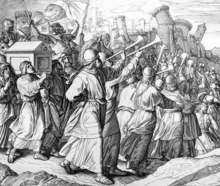Fall of Jericho
| Battle of Jericho (biblical) | |||||
|---|---|---|---|---|---|
 Depiction by Julius Schnoor von Carolsfeld (1794-1872) | |||||
| |||||
| Belligerents | |||||
| Israelites | Canaanites | ||||
| Commanders and leaders | |||||
| Joshua | King of Jericho † | ||||
| Strength | |||||
| 40,000[1] | Unknown | ||||
| Casualties and losses | |||||
| Nil | Herem | ||||
According to the Book of Joshua, the Battle of Jericho was the first battle of the Israelites in their conquest of Canaan. According to Joshua 6:1–27, the walls of Jericho fell after Joshua's Israelite army marched around the city blowing their trumpets. Excavations at Tell es-Sultan, the biblical Jericho, have failed to produce data to substantiate the biblical story,[2] and scholars are virtually unanimous that the Book of Joshua holds little historical value.[3]
Joshua 6:1-27
The story of Jericho is told in Joshua 6:1–27.
The first five books of the Hebrew Bible tell how Noah cursed Canaan to become a slave, and how God gave the land of the Canaanites to Abraham and his descendants. The children of Israel (descendants of Abraham) themselves became slaves in Egypt, but through Moses God brought them out of Egypt and to the borders of the promised land of Canaan. There Moses instructed them to seize the land by conquest, and placed them under the command of Joshua.
Joshua sent spies to Jericho, the first city of Canaan to be taken, and discovered that the land was in fear of Israel and their God. The Israelites marched around the walls once every day for seven days with the priests and the Ark of the Covenant. On the seventh day they marched seven times around the walls, then the priests blew their ram's horns, the Israelites raised a great shout, and the walls of the city fell. Following God's law of herem the Israelites took no slaves or plunder but slaughtered every man, woman and child in Jericho, sparing only Rahab, a Canaanite prostitute who had sheltered the spies, and her family.
Origins and historicity
In 1868, Charles Warren identified Tell es-Sultan as the site of Jericho. In 1930–36, John Garstang conducted excavations there and discovered the remains of a network of collapsed walls which he dated to about 1400 BCE. Kathleen Kenyon re-excavated the site over 1952–1958 and demonstrated that the destruction occurred c.1500 BCE during a well-attested Egyptian campaign of that period, and that Jericho had been deserted throughout the mid-late 13th century.[4] Kenyon's work was corroborated in 1995 by radiocarbon tests which dated the destruction level to the late 17th or 16th centuries.[5] A small unwalled settlement was rebuilt in the 15th century, but the tell was unoccupied from the late 15th century until the 10th/9th centuries.[2]
Most scholars agree that the book of Joshua holds little of historical value.[3] The book's origin is usually dated to a time far removed from the times it depicts,[6] and its intention linked with a theological scheme in which Israel and her leaders are judged by their obedience to the teachings and laws (the covenant) set down in the book of Deuteronomy, rather than as history in the modern sense.[7] The story of Jericho, and the conquest generally, probably represents the nationalist propaganda of the kings of Judah and their claims to the territory of the Kingdom of Israel after 722 BCE;[8] these chapters were later incorporated into an early form of Joshua written late in the reign of King Josiah (reigned 640–609 BCE), and the book was revised and completed after the fall of Jerusalem to the Babylonians in 586, and possibly after the return from the Babylonian exile in 538.[9] The combination of archaeological evidence and analysis of the composition history and theological purposes of the Book of Joshua led archaeologist William G. Dever to deem the biblical story of the fall of Jericho as "[not] founded on genuine historical sources" and "invented out of whole cloth."[10]
See also
- Ai (Bible)
- Biblical archaeology
- Bryant Wood, US biblical archaeologist and young earth creationist who supports the historicity of Joshua's biblical conquest of Jericho
- Early Israelite campaigns
- "Joshua Fit the Battle of Jericho", African-American spiritual about the battle
References
- ^ Joshua 4:13
- ^ a b Jacobs 2000, p. 691.
- ^ a b Killebrew 2005, p. 152.
- ^ Dever 2006, pp. 45–46.
- ^ Bruins & Van Der Plicht 1995, p. 213.
- ^ Creach 2003, pp. 9–10.
- ^ Laffey 2007, p. 337.
- ^ Coote 2000, p. 275.
- ^ Creach 2003, pp. 10–11.
- ^ Dever 2006, p. 47.
Bibliography
- Coote, Robert B. (2000). "Conquest: Biblical narrative". In Freedman, David Noel; Myers, Allen C. (eds.). Eerdmans Dictionary of the Bible. Eerdmans. ISBN 9789053565032.
{{cite book}}: Invalid|ref=harv(help) - Creach, Jerome F.D (2003). Joshua. Westminster John Knox Press. ISBN 9780664237387.
{{cite book}}: Invalid|ref=harv(help) - Dever, William G. (2006). Who Were the Early Israelites and Where Did They Come From?. Eerdmans. ISBN 9780802844163.
{{cite book}}: Invalid|ref=harv(help) - Jacobs, Paul F. (2000). "Jericho". In Freedman, David Noel; Myers, Allen C. (eds.). Eerdmans Dictionary of the Bible. Eerdmans. ISBN 9789053565032.
{{cite book}}: Invalid|ref=harv(help) - Killebrew, Ann E. (2005). Biblical Peoples and Ethnicity: An Archaeological Study of Egyptians, Canaanites, and Early Israel, 1300–1100 B.C.E. Society of Biblical Literature. ISBN 9781589830974.
{{cite book}}: Invalid|ref=harv(help) - Laffey, Alice L. (2007). "Deuteronomistic history". In Espín, Orlando O.; Nickoloff, James B. (eds.). An introductory dictionary of theology and religious studies. Liturgical Press. ISBN 9780814658567.
{{cite book}}: Invalid|ref=harv(help) - Moore, Megan Bishop; Kelle, Brad E. (2011). Biblical History and Israel's Past. Eerdmans. ISBN 9780802862600.
{{cite book}}: Invalid|ref=harv(help) - Bruins, Hendrik J.; Van Der Plicht, Johannes (1995). "Tell Es-Sultan (Jericho): Radiocarbon Results..." (PDF). Radiocarbon. 37 (2). Proceedings of the 15th International 14C Conference: 213–220.
{{cite journal}}: Invalid|ref=harv(help)
External links
 Media related to The Battle of Jericho at Wikimedia Commons
Media related to The Battle of Jericho at Wikimedia Commons
